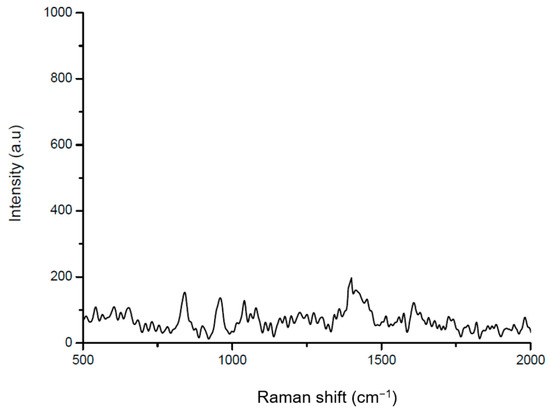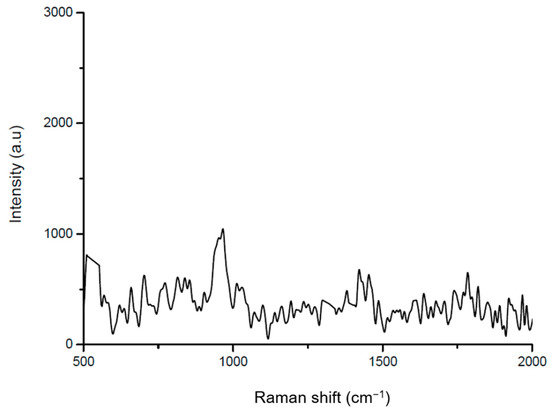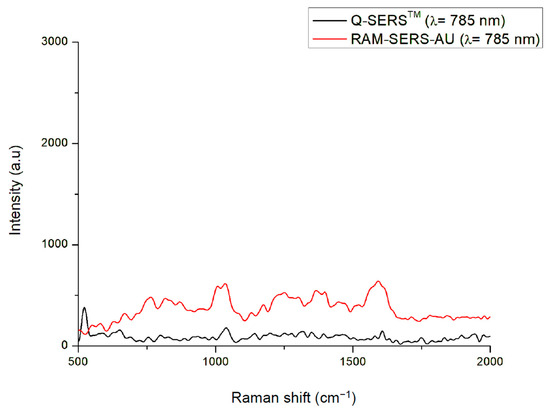Abstract
Surface-Enhanced Raman Spectroscopy (SERS) is a specialized spectroscopic technique based on the enhancement of the Raman scattering signals of molecules adsorbed or in close proximity to certain rough or nanostructured metal surfaces. It’s an extremely sensitive and powerful analytical tool for the investigation of biological molecules, revolutionizing the field of bioanalytical chemistry. The enhancement of Raman signal is due to various effects, the most important is thought to be the interaction between the electromagnetic wave associated with the laser used and the rough metal substrate (i.e., silver/copper/gold surfaces) on which the molecule is placed. When substrates are used, their characteristics are crucial for the reliability and sensitivity of experiments, as well as the ease of reproducibility of measurements. In the present work, we report on preliminary measurements to investigate the characteristics of two commercial SERS substrates, which have different nanostructures and patterns, properly designed to operate at an excitation wavelength of 785 nm. Aspirin C was used as a representative molecule to evaluate their application for SERS study of biological molecules, thanks to its characteristic fingerprint. Aspirin C is commercially available in the form of effervescent tablets, with acetylsalicylic acid and ascorbic acid as active principles with mainly analgesic and anti-inflammatory properties. The results are discussed also considering future applications for the detection of analytes of environmental interest.
1. Introduction
Surface-enhanced Raman Spectroscopy (SERS) is a variant of Raman scattering that has applications in various fields such as biomedicine, chemistry and biology and has attracted attention because it allows biological molecules of interest with different molecular weights to be identified rapidly, non-destructively and with a certain degree of sensitivity and reproducibility [1,2]. It has been shown to be an extremely sensitive and powerful analytical tool for the investigation of biological molecules [3,4,5].
The advantage of SERS compared to the Raman technique is the amplification of the signal by several orders of magnitude (up to 1010), using metal nanoparticles or directly using commercial SERS substrates, in which a few microliters of the solutions containing the analyte of interest are deposited in the active area [6,7]. Signal amplification results from the interaction between the electromagnetic wave associated with the laser used and the metal substrate (e.g., silver/copper/gold surfaces) on which the molecule is placed. The efficacy of this amplification is highly dependent on the metal substrate.
In this work, we have presented preliminary evaluation measurements of two commercial substrates, namely Q-SERSTM (Nanova Inc., Columbia, SC, USA) and RAM-SERS-AU (Ocean Insight), that are both optimized to be used with laser excitation at 785 nm and have different characteristics. Aspirin C was used as a representative molecule to evaluate their application for the SERS study of biological molecules, thanks to its characteristic fingerprint. It is commercially available in the form of effervescent tablets with analgesic and anti-inflammatory properties [8]. Its spectral characteristics, in addition to having ascorbic acid and acetylsalicylic acid as active principles, make it a target for study.
2. Materials and Methods
The commercial Aspirin C tablets contain 400 mg of acetylsalicylic acid and 240 mg of ascorbic acid (Vitamin C). To obtain the solution needed for measurements, 100 mg of the tablet was dissolved in 40 mL of water. An appropriate amount of the solution was placed on each of the SERS substrates being investigated and on metal and silicon discs. In all the cases, the solution was left to dry before performing the measurements.
The commercial SERS substrates used were Q-SERSTM, supplied by Nanova Inc., characterised by gold nanoparticles with a diameter between 15 and 60 nm, placed on a silicon wafer. The second SERS substrate used was RAM-SERS-AU, manufactured by Ocean Insight, consisting of a layer of gold nanoparticles placed on borosilicate glass. Little information is known about their design, except for the Q-SERSTM substrate which we know is made up of gold nanoparticles of different diameters placed on a silicon layer.
Raman spectra were acquired in the 500–2000 cm−1 range using the APE Scanning MicroRaman system (A.P.E. Research S.r.l., Trieste) and APE Raman Mapping software. The laser used has a wavelength of 785 nm and a maximum power of 350 mW. The exposure time was set to 1000 ms for each acquisition.
SERS spectra were analysed using Origin Pro 7.5 software (OriginLab, Northampton, MA, USA).
3. Results and Discussion
To compare the SERS performance of two commercial SERS substrates, Q-SERSTM and RAM-SERS-AU, by using Aspirin C as a representative molecule, the Raman spectrum of Aspirin C was obtained by analysing Aspirin C on a metal disc. A representative Raman spectrum is shown in Figure 1. In the quite noisy spectrum, some of the peaks of acetylsalicylic acid that are observed are visible at 1603 cm−1 and 1030 cm−1 [9,10], associated with the vibration of the carbonyl group and the presence of the aromatic ring, respectively. Weak signals of aspirin are visible in the region around 840 cm−1 (associated with out-of-plane bending C-H), 900 cm−1 and 1419 cm−1. As far as ascorbic acid is concerned, a band around 960–980 cm−1 associated with the C-H and O-H bending is visible [11].

Figure 1.
Raman spectrum of Aspirin C solution on a metal disc.
As stated in the Section 2, the Q-SERSTM is made from nanoparticles on a silicon layer, and the Raman spectrum of Aspirin C on a silicon substrate was recorded and shown in Figure 2.

Figure 2.
Raman spectrum of Aspirin C solution on silicon.
In the spectrum shown in Figure 2, the silicon signals are visible with greater intensity at 521 cm−1 and the band at 1000 cm−1 is associated with the second-order resonance peak of the silicon. Conversely, the Aspirin C peaks are not evident.
The spectra of Aspirin C placed on the two commercial substrates were detected and shown in Figure 3.

Figure 3.
SERS spectra of Aspirin C on Q-SERSTM (black line) and RAM-SERS-AU (red line) substrates by using excitation with a 785 nm laser and optical objective 50x.
The two spectra seem to be less noisy than the corresponding ones obtained without SERS substrates. The spectra of Figure 3 show the same bands at 1603 cm−1 and 1030 cm−1, associated with Aspirin C. For the spectrum obtained when the Q-SERSTM substrate is used (Figure 3, black line) the band around 521 cm−1 associated with the silicon substrate is also visible.
As a first tentative comparison of the enhancement efficacy of the two SERS substrates, the intensity of the Aspirin C-related 1030 cm−1 band, present in all the spectra, was used; the ratio between this intensity that was detected when the solution was placed on the SERS substrate and the corresponding intensity in the Raman spectrum (ISERS/IRaman) was calculated for both the substrates. The preliminary results show that the enhancement in the intensity of the 1030 cm−1 band with the RAM-SERS-AU substrate is higher than the corresponding value obtained for the Q-SERSTM substrate.
4. Conclusions
The results are promising for future applications for monitoring molecules of environmental interest and for designing sensors with advantages in terms of detection limits.
Author Contributions
Conceptualization, S.P. and I.D.; investigation, P.C., S.P., B.T. and A.N.; writing—review and editing, P.C., V.P. and I.D. All authors have read and agreed to the published version of the manuscript.
Funding
This research received no external funding.
Institutional Review Board Statement
Not applicable.
Informed Consent Statement
Not applicable.
Data Availability Statement
The data presented in this study are available upon request from the corresponding author.
Conflicts of Interest
The authors declare no conflict of interest.
References
- Cialla, D.; März, A.; Böhme, R.; Theil, F.; Weber, K.; Schmitt, M.; Popp, J. Surface-enhanced Raman spectroscopy (SERS): Progress and trends. Anal. Bioanal. Chem. 2012, 403, 27–54. [Google Scholar] [CrossRef] [PubMed]
- Kneipp, K. Surface-enhanced Raman scattering. Phys. Today 2007, 60, 40–46. [Google Scholar] [CrossRef]
- Camerlingo, C.; Portaccio, M.; Delfino, I.; Lepore, M. Surface-Enhanced Raman Spectroscopy for Monitoring Extravirgin Olive Oil Bioactive Components. J. Chem. 2019, 2019, 9537419. [Google Scholar] [CrossRef]
- Mun, J.; Lee, D.; So, S.; Badloe, T.; Rho, J. Surface-enhanced spectroscopy: Toward practical analysis probe. Appl. Spectrosc. Rev. 2019, 54, 142–175. [Google Scholar] [CrossRef]
- Cennamo, G.; Montorio, D.; Morra, V.B.; Criscuolo, C.; Lanzillo, R.; Salvatore, E.; Camerlingo, C.; Lisitskiy, M.; Delfino, I.; Portaccio, M.; et al. Surface-enhanced Raman spectroscopy of tears: Toward a diagnostic tool for neurodegenerative disease identification. J. Biomed. Opt. 2020, 25, 1. [Google Scholar] [CrossRef] [PubMed]
- Liu, Y.; Zhang, Y.; Tardivel, M.; Lequeux, M.; Chen, X.; Liu, W.; Huang, J.; Tian, H.; Liu, Q.; Huang, G.; et al. Evaluation of the Reliability of Six Commercial SERS Substrates. Plasmonics 2020, 15, 743–752. [Google Scholar] [CrossRef]
- Mosier-Boss, P. Review of SERS Substrates for Chemical Sensing. Nanomaterials 2017, 7, 142. [Google Scholar] [CrossRef] [PubMed]
- Khan, M.R.; Alothman, Z.A.; Naushada, M.; Ghfar, A.A.; Wabaidur, S.M. Simultaneous Analysis of Vitamin C and Aspirin in Aspirin C Effervescent Tablets by High Performance Liquid Chromatography–Photodiode Array Detector. J. Liq. Chrom. Related Technol. 2012, 35, 2454–2461. [Google Scholar] [CrossRef]
- Jamur, J.M.S. Raman spectroscopy analysis for monitoring of chemical composition of aspirin after exposure to plasma flame. Spectrosc. Eur. 2022, 34, 18–22. [Google Scholar] [CrossRef]
- Muthuselvi, C.; Dhavachitra, M.; Pandiarajan, S.S. Growth and Characterization of Aspirin Crystal in the Phosphoric acid Medium. J. Chem. Pharm. Res. 2016, 8, 804–814. [Google Scholar]
- Panicker, C.Y.; Varghese, H.T.; Philip, D. FT-IR, FT-Raman and SERS spectra of Vitamin C. Spectrochim. Acta A Mol Biomol. Spectrosc. 2006, 65, 802–804. [Google Scholar] [CrossRef] [PubMed]
Disclaimer/Publisher’s Note: The statements, opinions and data contained in all publications are solely those of the individual author(s) and contributor(s) and not of MDPI and/or the editor(s). MDPI and/or the editor(s) disclaim responsibility for any injury to people or property resulting from any ideas, methods, instructions or products referred to in the content. |
© 2023 by the authors. Licensee MDPI, Basel, Switzerland. This article is an open access article distributed under the terms and conditions of the Creative Commons Attribution (CC BY) license (https://creativecommons.org/licenses/by/4.0/).